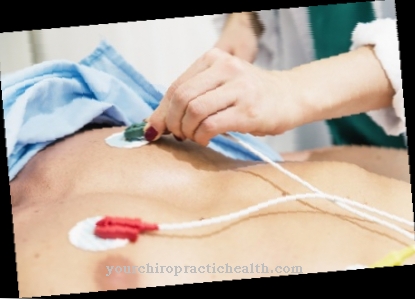The Auscultation represents one of the most important basic techniques of medical examination. Hardly a thorough diagnosis takes place without the help of this method.
What is auscultation?

The word "auscultation" has its origin in the Latin word "auscultare", which means "to listen carefully". This is exactly what happens with auscultation, also colloquially as Wiretapping is known.
The examiner records body noises through his ear and, if necessary, uses additional aids such as a stethoscope. The auscultation method has been used for diagnosing various organ diseases since ancient times. First of all, the noises of the organ concerned were listened to by simply placing the ear on the skin of the organ concerned. This is also known as direct auscultation. In the 19th century, indirect auscultation became possible, as hearing traps first appeared at this time.
The founder of this technique was the French doctor René Laënnec, who was the personal physician responsible for Napoleon Bonaparte's health. The devices for indirect auscultation continued to improve, so that the stethoscope as we know it today was born. By installing a modern membrane, a differentiated assessment of many organs such as the heart, the lungs or the abdomen is now possible.
Function, effect & goals
Heart and lung auscultation are most commonly used. These are usually part of the basic medical examination. During lung auscultation, the lung noises and any background noises are recorded. This enables clues for the further diagnostic procedure to be obtained.
For the auscultation of the lungs, the patient takes a seat on a height-adjustable stool and strips his upper body. Then he is asked to breathe in and out deeply with his mouth open. The examiner should proceed according to a fixed scheme so as not to forget any places. The procedure from cranial to caudal and first dorsal, then ventral is widespread. Translated for the medical layman, this means that auscultation takes place from top to bottom and first back and then front. So that side differences can be perceived, auscultation is always first left and then right at the same level. In each case inhalation and exhalation noises are awaited in order to be able to fully assess the ventilation conditions.
During cardiac auscultation, the heart sounds are recorded. Two heart sounds can be heard in healthy adults. They mark the beginning and end of the systole, i.e. the ejection phase of the heart. In children, there may be two other heart sounds. If these are found in adults, this always indicates a pathological condition. The heart sounds, which are always pathological and therefore have to be further clarified, must be distinguished from the heart sounds.
The patient can sit, stand or lie down for auscultation of the heart. The standard auscultation is performed at five different points on the chest wall. The sound of one of the four heart valves can be heard particularly well at each of these points. An exception to this is the Erb point, which is located on the parasternal left at the level of the third space between the ribs. Here all keys can be heard at the same volume. Therefore the examiner can get an overview of the heart function here. In order to be able to determine a possible pulse deficit, the examiner feels the radial pulse, i.e. the pulse on the wrist, parallel to auscultation.
Abdominal disorders are diagnosed using abdominal auscultation. The stomach is divided into four quadrants, which are then listened to one after the other with the stethoscope. Particular attention should be paid to bowel and vascular noises. Both missing and excessive noises are indications of illness. In this case, an intestinal obstruction is often the cause. But also flow noises can sometimes be auscultated. These are an indication of pathological changes in the aorta, i.e. the main artery. In pregnant women, the auscultation of the abdomen also serves to record the child's heartbeat.
Finally, there are other areas where auscultation can be helpful. So there is the scratch auscultation in which organ boundaries are determined. Carotid auscultation is also possible. This can be used to assess the condition of the carotid arteries.
You can find your medication here
➔ Medication for shortness of breath and lung problemsRisks, side effects & dangers
Heart and lung auscultation in particular is still a standard procedure today for performing a basic medical examination. The main advantages are that the methods have practically no side effects, are non-invasive and inexpensive and still provide a lot of information that is well suited for planning any further diagnostics that may be necessary. The auscultation of the abdomen also plays an important role in the primary diagnosis of diseases, some of which are life-threatening.
However, today the diagnosis is almost always supplemented by expanded methods, since a number of types of apparatus-based diagnostics are now available. Usually an ultrasound examination is initiated directly when pathologies are identified, which allows the examiner to get a much more precise picture of the current condition. Techniques such as scratch auscultation are rarely used nowadays, since sonography serves the same purpose, but is much more precise at the same time. Auscultation of the carotids is also often omitted and a direct sonographic examination is carried out instead, because this allows a more meaningful picture of the structure of the vessel wall and blood flow.
Nevertheless, due to its numerous advantages, auscultation still applies to basic medical techniques and is often used in everyday clinical practice.













.jpg)

.jpg)
.jpg)











.jpg)